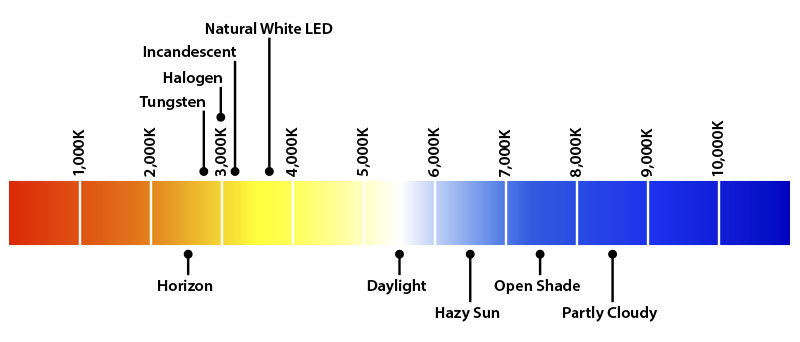When it comes to human color perception, our eyes can be deceived. This is partially caused by our humble brain, which is managing vast amount of information and processing it the best it can. It can also be related to genetics and the environment; we all see color a little differently. But above all, LIGHT has biggest impact on the colors we see in everyday life.
Without getting too technical, here is an introduction to the way light affects our perception of color.
RGB Color Circle
The temperature of light
The visible color spectrum, what we know as the rainbow (RGBIV), encompasses light wavelengths from approximately 380 to 720 nanometers and breaks down into three primary colors: red, green, and blue. We can mix these three colors in various combinations to create millions of beautiful colors. When we mix them in equal quantities, we perceive the color as white.
This is the foundation of the additive – RGB – color model, and the basis for human color vision.
White is Not a Lack of Color
As strange as it sounds, objects themselves don’t have color. They have properties that determine which wavelengths of light are absorbed, and which are reflected. It is the mixture of the reflected light that enters our eyes and gives us the perception of color.
Think about a red car sitting under a streetlight. All the colors from the halogen light are shining on it, yet we only see red. That’s because the car’s paint is absorbing the green and blue rays of the white light and reflecting the red. When you look at the car, your retina receives the reflected red light and sends a message to the brain: This car is red.
The shade will change however as the color temperature of the sunlight changes. This quick video demonstrates it well.

While the car looks red under noon daylight, it appears bluer under the night sky, and more yellow under fluorescent and horizon sunlight. However, without a point of reference, they all just look red.
Human Color Perception and Color Memory
Our brains have “learned” how objects should look, and we apply this knowledge to everything we see in everyday life.
Take white, for example. Magazine pages, newspapers, and printer paper are all white, but if you lay them together, you’ll see that each white is actually different. The newsprint will appear more yellow, and next to the newspaper the printer paper will probably look even brighter than you originally thought. That’s because our eyes tend to capture the brightest part of the scene, call it white, and judge all other colors relative to this “bright-level.”
Here’s a cool optical illusion from Beau Lotto that illustrates how our color memory can completely change the appearance of a color.

Optical Illusion images courtesy of R. Beau Lotto
The center squares on the top and front side of the cube look different – orange on the front, brown on the top, right? But when you mask the rest of the squares, you can see the two are identical. That’s because our brain subconsciously factors in the light source and mentally corrects the color on the front of the cube as shadowed. Amazing, isn’t it?
Without a point of reference, we each perceive color in our own way. Different people pick up on different visual cues, which changes how we interpret and perceive colors. This is very important to understand in industries where accurate color is crucial.
Assessing Human Color Vision
The Farnsworth Munsell 100 Hue Test, or FM100 Hue Test for short, is a highly effective method for evaluating an individual's ability to discern color. The test requires the use of standardized daylight conditions such as those found in X-Rite’s SpectraLight QC and Judge QC light booths. This test can be purchased on our website, and participants in our Fundamentals of Color and Appearance (FOCA) seminar will take it as part of the course.


